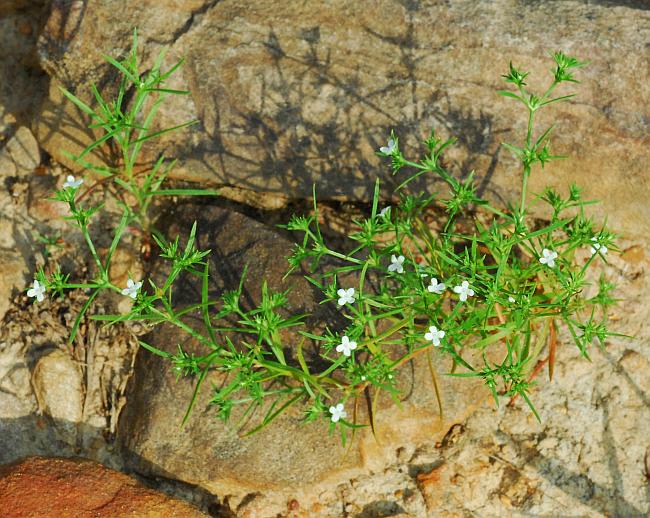Polypremum procumbens L.
Juniper-Leaf

Native
CC = 4
CW = 5
MOC = 10
© SRTurner
Polypremum procumbens L.Juniper-Leaf | |
 |
Native CC = 4 CW = 5 MOC = 10 |
© SRTurner |
|
Family - Tetrachondraceae Habit - Perennial forb, often forming dense tufts of short, densely leafy, overwintering stems toward the end of the growing season
Stem - Spreading to loosely ascending, to 25 cm long, often branched dichotomously, angled or ridged, at least toward the base, slightly roughened with sparse hairs along the angles.
Leaves - Basal and opposite, simple, sessile, entire. Bases of each leaf in a pair connected by a small stipular membrane. Leaf blades 0.4-2.5 cm long, linear or nearly so, often relatively stiff, tapered to a sharp point at the tip, the margins slightly roughened with sparse hairs.
Inflorescence - Small, dense, sometimes branched clusters, terminal on the branches, rarely reduced to solitary axillary flowers, with short leaflike bracts.
Flowers - Perfect, perigynous, subtended by a pair of short leaflike bracts. Calyces 2-3 mm long, persistent and sometimes becoming slightly enlarged at fruiting, deeply 4-lobed, the lobes lanceolate, relatively thick, sharply pointed at the tips. Corollas 2-3 mm long, 4-lobed to about the midpoint, white, the lobes broadly elliptic, broadly spreading at maturity, the throat with a dense ring of short hairs. Stamens 4, alternating with the corolla lobes, the filaments attached in the corolla tube, the anthers not exserted, attached at their midpoints, yellow. Pistil 1 per flower, of 2 fused carpels. Ovary about 1/2-inferior, 2-locular, with numerous ovules, the placentation axile. Style 1, very short, the stigma 1, capitate.
Fruit - Capsules, 1.8-2.5 mm long, obovate to elliptic in outline, somewhat flattened, shallowly notched to rounded or very bluntly pointed at the tip, each face with a slightly concave suture line, dehiscent from the tip along the sutures, glabrous. Seeds 0.2-0.4 mm long, irregularly cubic, the surface somewhat translucent, yellow.
Flowering - June - October. Habitat - Pond margins, sand prairie swales, wheel ruts, crop field margins, open disturbed areas, usually in sandy substrate. Origin - Native to the U.S. Lookalikes - Houstonia longifolia, H. nigrigans, Heliotropium tenellum. Other info. - This little species is uncommon in Misssouri, found mostly in a few Bootheel counties. Its U.S. distribution occupies the southeastern quadrant of the country, and its range also extends into Central America and elsewhere. The plant can have an appearance similar to some species of Houstonia, but unlike them, its flowers do not have exserted stamens. The four corolla lobes differentiate this plant from another lookalike, glade heliotrope (Heliotropium tenellum). Photographs taken in McGee Creek State Park, Atoka County, OK, 7-26-2016 (SRTurner). |